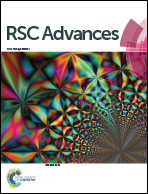Ultrasonic preparation of tungsten disulfide single-layers and quantum dots
Abstract
Natural raw mineral tungstenite (WS2) was exfoliated to single-layer sheets using high intensity ultrasound. Exfoliation of bulk layered materials, such as WS2 by ultrasound is an attractive way to a large-scale preparation of mono- or few-layered crystals. To evaluate the quality of delamination, X-ray diffraction, Raman spectroscopy and microscopic techniques (TEM and AFM) were employed. The obtained exfoliated product served as a precursor for quantum dot preparation using simple refluxing in ethylene glycol. The synthesized WS2 quantum dots were characterized by photoluminescence spectroscopy and AFM microscopy. Exfoliated WS2 can thus join the group of similarly prepared single-layers of MoS2 or graphene.


 Please wait while we load your content...
Please wait while we load your content...